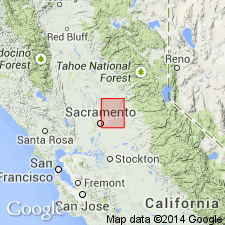
- Usage in publication:
-
- Ione formation*
- Modifications:
-
- Original reference
- Dominant lithology:
-
- Clay
- Sandstone
- Lignite
- AAPG geologic province:
-
- Sacramento basin
- Sierra Nevada province
Summary:
Ione formation. During Neocene period the auriferous gravels accumulated on slope of Sierra Nevada, and at same time there was deposited in the gulf then occupying the Great Valley a sedimentary series consisting of clays and sands to which name Ione formation has been given. The largest development occurs south of American River. The strata form characteristic flat-topped hills, and consist of a succession of light-colored clays and white or yellowish-white sandstones. Is usually overlain by a few feet of reddish Pleistocene gravel and rests on Chico formation. [Age is early Tertiary (Eocene).]
Source: US geologic names lexicon (USGS Bull. 896, p. 1018-1019).
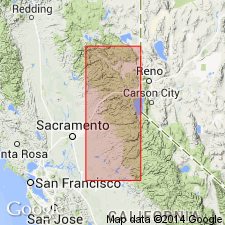
- Usage in publication:
-
- Ione formation*
- Modifications:
-
- Revised
- AAPG geologic province:
-
- Sierra Nevada province
Turner, H.W., 1894, Geological notes on the Sierra Nevada: American Geologist, v. 13, p. 228-249.
Summary:
Pg. 229-249. Ione formation consists of white shales, clay, and sand of Miocene age. Is best developed in Amador and Calaveras Counties, northern California, where it is separable into:
1. Ione clay rock or tuff, 100+ feet
2. Ione sandstone, 100+ feet
3. White clay and sand beds containing coal seams, 800+ feet.
Source: US geologic names lexicon (USGS Bull. 896, p. 1018-1019).
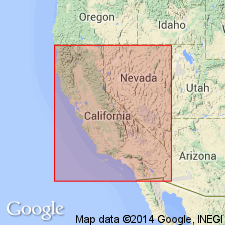
- Usage in publication:
-
- Ione formation
- Modifications:
-
- Revised
- Age modified
- Biostratigraphic dating
- AAPG geologic province:
-
- Sacramento basin
- Sierra Nevada province
Summary:
Pg. 347-419. Ione formation restricted to lower two members of type section, i.e., to the white clay and sand beds containing coal seams and the overlying white or red sandstone. The upper clay rock or rhyolite tuff formerly included is now considered to probably be Miocene, and is here excluded. It is separated from underlying Ione formation restricted by an extensive erosion period. The lower clays of the Ione were not formed from rhyolitic tuffs, as heretofore supposed. As here restricted the formation is a lithologic unit serviceable in mapping and valuable in correlation, and it can be traced for more than 200 miles. The work of writer lends support to belief the Ione is contemporaneous with the white quartz gravels of Sierra Nevada. The Ione is composed of delta deposits formed at mouths of many westward-flowing streams. The presence of marine fossils in upper part shows that it accumulated on shores of an Eocene sea. From 1913 to 1916 R.E. Dickerson made valuable contributions to our knowledge of the Ione by finding Eocene marine fossils in it. He designated the Ione as the SIPHONALIA SUTTERESIS zone, which he considered the uppermost part of Tejon Eocene. He concluded the Ione is the marine or estuarine equivalent of the auriferous gravels of Sierra Nevada. In 1921 B.L. Clark referred Dickerson's uppermost Eocene SIPHONALIA SUTTERESIS zone to the Meganos middle Eocene. This reference applied especially to the marine Ione, such as Dickerson described from Oroville Table Mountain and Marysville Buttes, but not to type section. Perhaps latter was excluded because of its limited fauna and poor preservation of the forms obtained.
Source: US geologic names lexicon (USGS Bull. 896, p. 1018-1019).
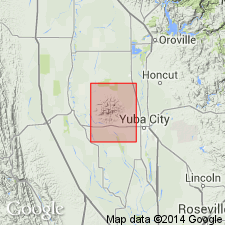
- Usage in publication:
-
- Ione sands
- Modifications:
-
- Areal extent
- AAPG geologic province:
-
- Sacramento basin
- Sierra Nevada province
Summary:
Pg. 112, 124+. Ione sands. Very siliceous sands with anauxite; usually pure white, but often stained brown, pink, or purple. Thickness 100 to 150 feet. Underlie Butte gravels, with minor disconformity. The term Ione is applied to these sands in sense adopted by Dr. V.T. Allen, who has permitted this brief advance statement of his work. Previous to Allen's work the term had been used so widely to include deposits of very different lithology and often of different ages, that it had long since lost all accurate connotation. Allen has redefined the term, restricted it to the quartz-anauxite sands of the Meganos. His work indicates clearly that his peculiar lithological unit is of surprising uniformity throughout wide belt along foothills of Sierra Nevada, and that it probably represents a single persistent horizon. He has shown that Ione sands are probably the age equivalents of the "Bench gravels" of the Sierra, and that they were chiefly derived by the erosion of an intensely weathered granitic series. The formation is often characterized by strong current bedding. [Age is early Tertiary (Eocene).]
Source: US geologic names lexicon (USGS Bull. 896, p. 1018-1019).

- Usage in publication:
-
- Ione formation*
- Modifications:
-
- Overview
- AAPG geologic province:
-
- Sacramento basin
- Sierra Nevada province
Summary:
Ione formation. Allen's 1929 restricted definition of Ione formation is present [ca. 1936] adopted usage. The "Ione clay rock or tuff" at top of Turner's Ione formation has been named Valley Springs formation and assigned to late Tertiary (Miocene). Age is early Tertiary (Eocene).
Named from exposures at Ione, Gold Belt region, [Ione 7.5-min quadrangle], Amador Co., northern CA, where it overlies Mariposa slate. It has been described as younger than Tejon, as = upper part of Tejon, and as older than Tejon and = Meganos formation.
Source: US geologic names lexicon (USGS Bull. 896, p. 1018-1019).
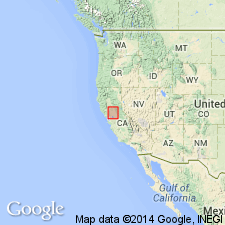
- Usage in publication:
-
- Ione formation*
- Modifications:
-
- Revised
- AAPG geologic province:
-
- Sacramento basin
Summary:
Described in columnar section at Fig Tree Gulch as silty, micaceous, fine sandstone with plant remains and marine fossils including carinated TURRITELLA MERRIAMI in lower part. Upper part consists of coarse white sands. Includes Allen's (1929) Dry Creek formation near Oroville as "Dry Creek" sandstone member (name in quotes because name already used for formation in Montana).
Source: GNU records (USGS DDS-6; Menlo GNULEX).
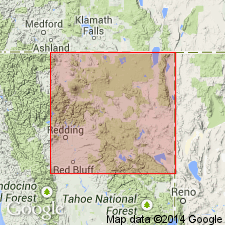
- Usage in publication:
-
- Ione Formation*
- Modifications:
-
- Areal extent
- AAPG geologic province:
-
- Sacramento basin
Summary:
Rocks originally included in Ione Formation by Diller (1895) in Lassen Peak sheet are here included in Montgomery Creek Formation.
Source: GNU records (USGS DDS-6; Menlo GNULEX).
For more information, please contact Nancy Stamm, Geologic Names Committee Secretary.
Asterisk (*) indicates published by U.S. Geological Survey authors.
"No current usage" (†) implies that a name has been abandoned or has fallen into disuse. Former usage and, if known, replacement name given in parentheses ( ).
Slash (/) indicates name conflicts with nomenclatural guidelines (CSN, 1933; ACSN, 1961, 1970; NACSN, 1983, 2005, 2021). May be explained within brackets ([ ]).

